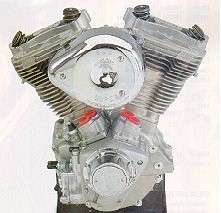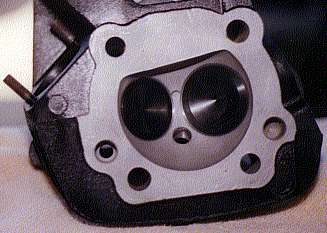| Performance and
Technical information on Stage 3 modifications to a Harley-Davidson 1340 Evolution
motorcycle engine. Build
low cost, maximum performance street engine
or
How to get 95HP from your 1340 Evolution engine.
 |
You have decided that your current
engine isn't getting the job done. You have made Stage 2 changes to your bike and are still looking for more
power. You are ready for a series Stage 3 engine. These modifications are a little more
complicated than the bolt-on Stage 3 engine.
Better flowing heads and increased compression ratios are the usual way to
make 90+ horsepower. Motorcycle Performance Guide is about
to blow the lid off this idea. We achieved 95.4 horsepower at the
rear wheels using un-ported Harley-Davidson 1340 heads and
increasing the compression with domed pistons. Contrary to what many
performance shops try to tell you, we were able to break the 90 horsepower
mark without larger valves, porting and polishing the Evolution
heads.
There are many companies out there that are
competing for the dollars that Harley-Davidson owners are willing to spend on
their bikes. As an owner, you will be bombarded with a vast array of promises, claims and
inaccuracies in an effort to separate you from your money. Reading between the lines on
many of the performance claims can be bewildering.
Does the Harley-Davidson world need
another engine modification article? We decided it does, since the results
obtained by the engine upgrades listed here provided significantly better results than
those documented by the popular magazines aimed at the V-Twin crowd. The Motorcycle
Performance Guide staff continues to obtain better results than the "experts" in
the press and most performance shops.
How to build your own Stage Three engine
 |
This Stage Three engine requires internal changes to the engine.
Disassembly of the top end of the engine is required. Some special tools
and training is required to perform these upgrades. Unless you are a very good
mechanic and have access to a machine shop, it is recommended you find a competent shop to
perform these modifications. For those of
you that want to assemble the engine yourself, Motorcycle Performance Guide recommends you
obtain the proper service manual for your bike.
Over the past several years we have installed and
tested many manufacturers components. The list of parts used in building
this engine is the end result of this testing. The best and least
expensive of the components were selected and tested as a single package.
The horsepower your bike produces may vary from the results produced here.
If you use different parts or do not properly tune your engine, power may
change significantly. Motorcycle Performance Guide assures you that the
parts list and results are presented as accurately as possible.
All the parts used
in this engine are
readily available through local shops, after-market parts companies
and your Harley-Davidson Dealer. The components were
installed and tested on a 1994 FXD Dyna Low Rider. Dyno tuning is required to
achieve the results listed. All components were installed according to the manufacturer
instructions supplied.
 | Building your Stage 3 engine
Disconnect battery
Drain gasoline from tank
Remove gas tank
Disassemble the engine top end
Remove heads, cylinders and pistons
Remove cam, lifters and lifter blocks
Remove old cam bearing
Remove stock clutch
Send heads to machine shop to install parts and do valve job
Send cylinders to machine shop to fit new pistons
Install cylinders with new pistons
Install upgraded cylinder heads
Install new cam bearing
Install new cam
Install ignition module
Install lifter blocks with new lifters
Install adjustable pushrods
Install intake manifold and carburetor
Install new clutch
Install exhaust system
Remove exhaust system baffles
Change engine oil and filter
Change transmission oil
Add primary chaincase oil
Install new spark plugs
Set static ignition timing
Road test the bike
Dyno Tune the bike
Enjoy the ride |
The results of the Dyno testing were excellent. The test results showed the engine
producing 95.4 horsepower @ 5600 RPM and 95.3 ft. lbs. of torque @ 4600 RPM.
While the power curve on this engine
was optimized for drag racing and dyno shootouts, it still manages to
produce over 80 ft.lbs.. of torque from 3900 to 6000 RPMs. That is some
serious power to the rear wheels.
This engine is producing
40 horsepower more than a stock bike. Not bad for the relatively low investment in time and money required to get these results.
Just how fast is fast enough is a matter
of opinion. This 94 FXDL was taken to the drag strip in order to establish what 1/4 mile times could be
done. The bike proved to be a very potent H-D drag race bike by turning times in the
11.80 range with 114 MPH speeds. The bike will accelerate to 90+ MPH in 1/8
of a mile.
The results are due to a well matched set of parts
being installed in the engine. This is an engine combination that many
Harley shops do not want you to know about. Who would believe stock
Evolution heads could make over 90 horsepower.
Just because the heads were not ported and
polished, don't think that you can achieve the high horsepower numbers
without making some changes to the heads. The Manley performance valves
and the 5 angle valve job provide big improvements in air flow through the
ports. This is an important part of making good horsepower. Don't forget
to have the spring clearance set for .600" lift cams. The SE-57 has a
.575" bump on it. The JE 10.5:1 pistons are machined to accept a high
lift cam.
The performance of the Screamin Eagle SE-57
camshaft was impressive, producing strong torque to match the horsepower
potential. Past experience indicated that cams with 252 degrees of
duration make excellent street cams. This Harley-Davidson camshaft did not
disappoint.
The SuperTrapp 2-1 exhaust system with the
internal baffles removed was an important component in creating this high
horsepower. Installation of the baffles and use of 18 disks results in a
5-7 horsepower drop, but the torque remains the same. The horsepower curve
peaks drops to 5700 RPM and the torque peak drops to 3900 RPM. This change
in power curve makes the engine very potent on the street.
If don't have the money to purchase all the
parts listed for this engine, we recommend you make the following changes
 | Use your re-jetted CV carburetor in
place of the Mikuni HSR-42. The CV is capable of supporting a 90 HP
engine. Just keep your Screamin Eagle air filter clean and make sure
the carburetor is well tune. |
 | The Cycle Shack Slash-cut exhaust system
or Slip-on mufflers on stock header pipes are a low cost alternative
to the SuperTrapp 2-1. While the maximum power of the 2-2 exhaust
system is not going to match the 2-1 system, expect only a small
horsepower drop. |
 | The Barnett Extra Plate clutch is a good
alternative to the Rivera Pro Clutch. With the extra power available
from the engine, the stock clutch will not last very long if your
riding style is aggressive. While the Barnett upgrade will not last
like the Rivera, the cost difference is significant. |
The ability to create similar results with
other manufacturers parts is a distinct possibility. Motorcycle Performance Guide
choose to
work with parts that had proven ability to provide increased horsepower and torque. If you
use the parts listed in the "Ultimate Street Engine" series of articles, there
is little doubt in our minds that your can duplicate our results, provided the engine is
in good mechanical shape and properly tuned. Optional parts that have similar
specifications to the components used in our engine should provide very similar results. A
matched set of engine components, careful assembly and dyno tuning are the keys to
building a killer street engine. May your results be a successful as those we have
documented. |